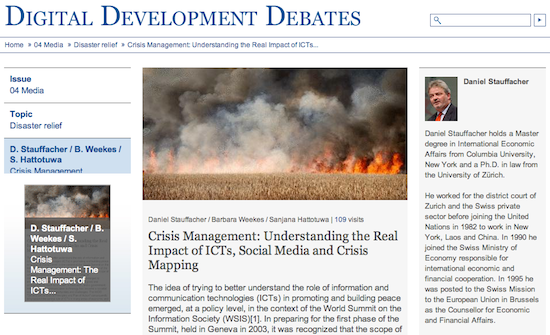Digital Development Debates published by the Deutsche Gesellschaft für Internationale Zusammenarbeit (GIZ) GmbH features this week a short essay from the Foundation looking at the use of ICTs in crisis response, peace-keeping, conflict resolution and state-building.
Read the article in full here.
As we note in the introductory passages,
“Moving from a rigid traditional top-down hierarchical approach, the humanitarian community and the military are increasingly relying on mobile, inclusive and interactive tools, building on a wealth of information gathered from locals and those outside traditional humanitarian communities. This transformative switch to a more bottom-up and waterfront approach, focusing on the individuals in crisis areas, means encouraging communities and individuals to be prepared, self-sufficient and reliant in times of crisis and conflict.”
Eschewing the hype and inaccurate claims often made around the use of ICTs in crisismapping and humanitarian relief today, our short article flags serious questions around emergent policies, practices and thinking in the use of new online and mobile technologies for relief and aid work.
“In summary, approaching humanitarian relief with an increasing emphasis on ICT brings with it hope for a better future, but also significant challenges. It is true that UN agencies and many humanitarian organizations increasingly use web-based social networks and ICTs as an integral part of their operations, including content from Twitter and Facebook. Stressing the need for accountability, many organizations suggest that new tools and mobiles have significantly improved the ability of victims to help themselves and each other after a disaster.
Nevertheless, the challenges remain formidable. How can the humanitarian community and other actors physically assess the mountains of data that come in? There is very little time in crisis situations and even less time for reading thousands of emails and text messages. What steps do the humanitarian community need to take in order to manage this process? How can the accuracy of the information coming into a given platform be validated, in particular in conflict situations where misinformation is often used as a weapon? How can individuals in conflict situations who provide valuable information be protected? What responsibility do technology platform providers have? What happens when collected information cannot be acted on? How can the links between the information gathering and implementation be improved? How can responders ensure that new systems uphold the “do no harm” principle of the humanitarian community? What criteria exist, or should exist, for ICT providers (including crisis mappers and social media) to determine which crises they should address or “map”? Who actually owns and has access to ICTs that could be of use post-disaster as well as for disaster preparedness?
The question of accountability and the responsibility to asses new ICT tools and platforms from the perspective of the disaster-affected community is still a very important issue. This requires humility and the eschewing of what is a tendency amongst actors in relief work to take credit when things go right, and disavow responsibility when expectations are either not met, go unheeded, or, in some cases, even threaten lives.”

